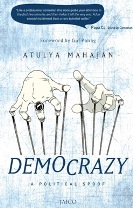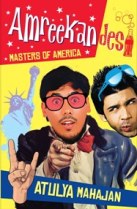Cross Connection - Inter Racial Weddings
If England and America are two nations divided by a common language, India is a collage of nations glued clumsily by a common desire to ridicule one another.
For example, a Bengali will tell you solemnly that the word Marwadi is synonymous with unscrupulous buccaneers even though Bengal’s economy today rests majorly on their hard work. A Marathi will tell you angrily that the word Bihari means job-stealer, while a Northy will affirm that a Malyali is one who can voice undecipherable sound bytes in the name of ‘language’. A Punjabi will swear by his patiala-peg that all Bengalis are effeminate poets while the Bengali will in turn write a book accusing the Sardar of being philistine and gaulish.
So one can well imagine the pandemonium that breaks out among relatives, neighbours, and outright strangers when a ghar-ka-beta walks in with a girl from a doosra gaon. The girl is viewed as a Japanese fighter pilot hell bent on disturbing the tranquility of Pearl Harbour (i.e. the groom’s house).
Typically, Indian marriages are all about rank strangers discussing intimate details of the to-be-wed, momentarily forgetting their own domestic worries and focusing the sun’s rays on the hapless couple through a magnifying glass. This continues till the couple feels the scorch on their backs and run for their lives to seclusion, euphemistically termed as the “honeymoon”.
So when an alien-beti walks in, she causes several problems.
1) She does not understand the local language. So she cannot participate in a vernacular conversation that is intended to dissect her hitherto little known love life. An utter disappointment!
2) One cannot fault her for not following the all-important local customs because she does not know them in the first place. So, no chhi chhi, no hare ram hare ram for entering the house with the wrong foot, or wearing the bangle on the wrong wrist, or forgetting to wear the all-important mangal sutra, or walking in public without the ghunghat on!
3) One cannot test her in the kitchen! She may not know to tell between mustard oil and phenyl but may know to cook five types of dosas and nine types of idlis to make a unique breakfast for an entire fortnight. So, does one consider her a good cook or not? You see her premise is uncharted territory for the jury.
On the other hand if she is intelligent she can use this ignorance to her advantage, by learning a few vernacular sentences (like my wife who’s Konkani by birth but has learnt to say, kemon achho, ki korchho, kothae giechhile and kokhon khabe in Bengali very quickly) and throw a doubting neighbour off guard. She can also learn a few local dishes which would have been an “OK” for a local girl but is an “A+” for this alien-bahu. A slippery customer this alien-bahu can be, I tell you.
As our hallowed epics tell us, the groom however need not pass any such agnipariksha. If there is one thing in common across most cultures in our country it is the deification of the boy-child notwithstanding the simpleton he is. A stupid one is considered the incarnation of Bholenath; a rotund sloth an incarnate of Ganesha; a philandering one is Lord Krishna himself, and a headless gym-holic must be an avatar of Bhima. With such reputation the alien-damaad struts in his beloved’s household. He wears a smile with a carefully measured aperture (ranging from 0 to 32, the unit being the number of teeth he is allowed to show). He cannot talk the vernacular tongue, nor does he have a common topic to share with the several Predator-like eyes that are scanning every inch of his being like a US drone. So he looks for a familiar face in the bride’s household and strikes an animated conversation that starts with the humid weather and inevitably ends with the salary that he gets paid and the number of foreign-trips he has made.
The most feared part of this alien-damaad’s endeavor to assimilate with the bahu’s culture however is the food! A girl will scream at a restaurant if she finds an unfamiliar object on her plate, but cometh the marriage hour rest assured that she will gulp an octopus down her throat if that is the custom of her in-laws. The damaad will however have to be force-fed at the girl’s house like they show in Saza-E-Kala Pani. If it is a North Indian boy charting in South Indian waters, he will dabble with the drumstick like an oar in a pool of sambar and look morosely at the curd-rice wishing it was kheer. The “mixture” will remind him of his Patiala-peg and the gobi manchurian of the roasted chicken legs. If it is a Southy lad in Northy waters, only a pilgrimage to the Tirupati temple will suffice in washing the sins of which he will be a part. It will start with a drunken revelry with everyone ranging from the bride’s grandmother to the colony’s watchman doing Bhangra on the road as if no one’s watching. A non-vegetarian meal will follow where every specie will be represented on his plate. If he is unlucky indeed he will be made to sit through a qawwali/antakshari session where discordant acoustic missiles will be hurled at his eardrum. Eventually, he will have his freedom sleeping on a bed underlain with roasted paapad.
The real stars however in such weddings are the parents. They go largely unnoticed despite the concessions they make during this day for their child’s happiness. Imagine asking a veteran Viking warrior to abandon his inherent boisterousness and adorn a toga on his ward’s wedding and move around with a pallid face of a Roman senator (or vice-versa). With all the liberal mindset in the world it isn’t easy to act and be a part of an alien culture (that too on the all-important night of your bete/beti ki shaadi). You may watch the 1967 Hollywood classic Guess Who’s Coming to Dinner to remove your doubts. For the bride and the groom they have each other at the end of the cataclysmic day. A parent sits dazed wondering if the event went well or was it a disaster. Their heads buzzing with the vision of rituals they did not understand in a place full of people who look and talk different. It can be unnerving to say the least.
In a world today that is rapidly going grey (with whites, browns, yellows, and blacks breaking socio-cultural barriers with startling audacity) India is playing its part from the forefront (knowingly or unknowingly). In ridiculing each other we are perhaps becoming more aware of the slew of cultural shades our country exhibits to the outside world. That would explain the million momo-stalls in Bangalore, a Bengali bride wearing a lehenga at her wedding and rasagollas being served at a ceremony in Andhra! Soon, we may even collectively begin to understand what the word “Indian” actually means.
[Guest post by Saptarshi Moitra who blogs here. If you would like to write for amreekandesi.com, please read this first, and shoot me a note at [email protected]]




